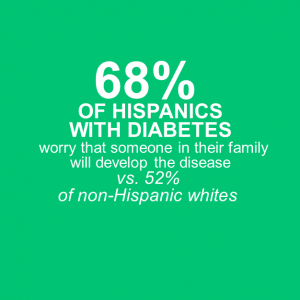Hispanics account for 1 out of every 5 adult diabetic sufferers, yet there seems to be a lack of outreach among healthcare organizations to educate patients on the risks and management of this disease. A survey conducted by the National Alliance for Hispanic Health provides key insights on the challenges and opportunities towards helping Hispanic diabetics. Here are a few takeaways:
A big family health concern
According to the survey, 68% of Hispanics with diabetes worry that someone in their family will develop the disease vs. 52% for non-Hispanic whites. This comes as no surprise as last year’s Latinum study showed that 78% of Hispanics said that they worry a “great deal” about the health and wellness of their families vs. 59% for non-Hispanics. Diabetes is obviously a major family health concern for this population.
A need for stronger patient-provider relationships
Among Hispanics who have diabetes, 77% said that healthcare providers are their most trusted source for health information, yet only 12% cited seeing one regularly in order to manage the disease. This suggests that there is a need for more relevant healthcare messaging encouraging Hispanics to visit their doctors. In fact, at this year’s DTC Perspectives’ National Conference, Pfizer’s Lisa Lieberman, Director of U.S. Marketing for Lyrica, agreed that the gaps in diagnosis for a related illness called pDPN (painful diabetic peripheral neuropathy) aren’t surprising as there’s been a lack of targeted outreach to Hispanic communities — especially within this therapeutic area.
Opportunity to improve behaviors
The survey also shows that 87% of diabetic Hispanics believe that a person can take action to prevent the disease. However, Hispanics were unclear what those actions are. “Eating a healthy diet” was the most common selected at over 70%. But “being physically active,” “maintaining a healthy weight” and “seeing a health provider regularly” did not seem to be considered important preventative measures – with only 42%, 16% and 10% of Hispanic diabetics respectively choosing them. Part of healthcare industry messages should be focused on improving awareness about holistic approaches to diabetes prevention. And, for Hispanics, culture and language should help frame those messages. During Lieberman’s pDPN discussion she said, “It was important for us to communicate to Hispanics in both English and Spanish…We found that in our media plan, we weren’t reaching them all and we weren’t reaching them effectively.”
To quote Leiberman: “We want better outcomes for all our patients.” More relevant communications to the Hispanic community will help all healthcare companies accomplish that.
